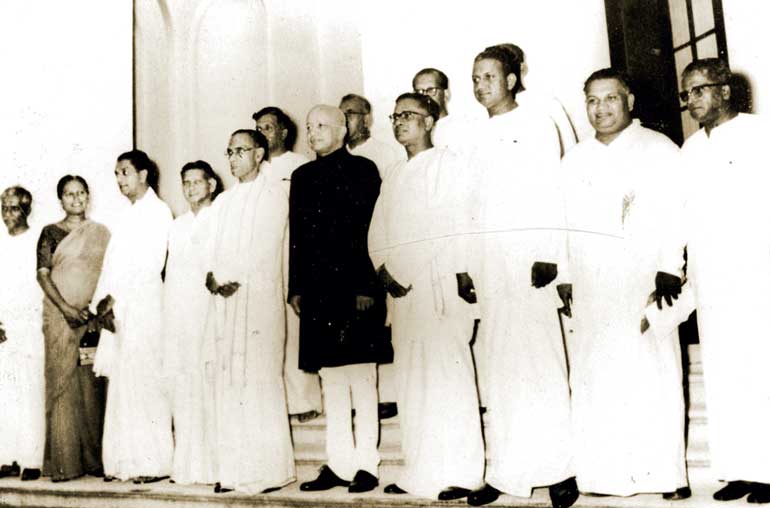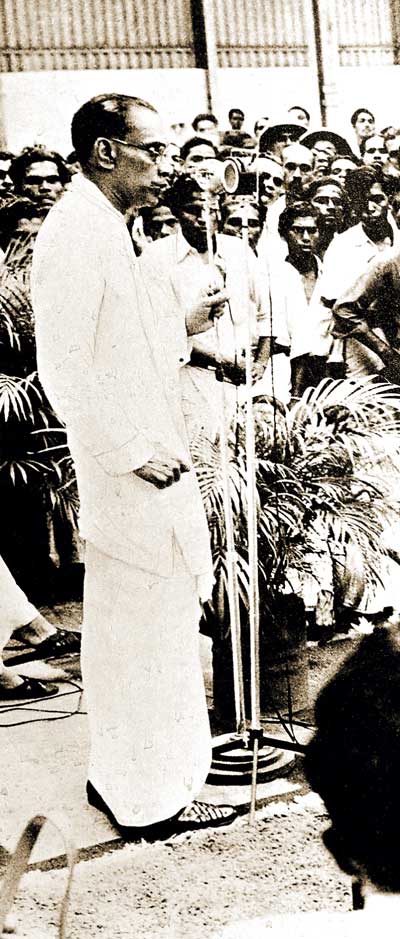Friday Dec 26, 2025
Friday Dec 26, 2025
Saturday, 27 August 2016 00:10 - - {{hitsCtrl.values.hits}}
The first Cabinet of Ministers, 1947
At the inaugural meeting of the newly-founded Sri Lanka Freedom Party
S.W.R.D. Bandaranaike at a mass rally during the general election campaign, 1956
Swearing-in as Prime Minister after the 1956 general election victory
First Throne Speech of the new Government
 With the Cabinet of Minister, 1956
With the Cabinet of Minister, 1956
By D.C. Ranatunga
Date: 10 July 1951. “Malice towards none and charity for all.” So saying, Senior Minister and Leader of the House, S.W.R.D.  Bandaranaike crosses over to the Opposition from the ruling United National Party.
Bandaranaike crosses over to the Opposition from the ruling United National Party.
In two months he had formed a new party – the Sri Lanka Freedom party, which is celebrating its 65th anniversary on 4 September.
By then he was a seasoned politician, having been in the political arena for over 30 years. Entering the Colombo Municipal Council as a member in the late 1920s, he broke into national politics with his election from Veyangoda electorate to the first State Council in 1931 under the Donoughmore Constitution.
He had an unbroken record as a minister since 1936 when he served as Minister of Local Government in the Board of Ministers in the second State Council. In 1947he was one of the 14 Ministers in the D.S. Senanayake Cabinet. He retained the Local Government portfolio with another subject – Health – being added on.
In the 1947 general election held under the Soulbury Constitution, the Veyangoda electorate was renamed Attanagalla and contesting from the UNP he polled the largest number of votes in a single constituency, with 31,463 votes out of 36,489 recording the highest majority (26,854) in the whole country.
The 1947 election was the first where political parties contested a general election in Sri Lanka. Earlier, during the elections to the State Council, candidates came forward as individuals. However, in the 1930s numerous political organisations were formed. They were working mainly towards breaking away from the colonial status and gaining self-government. The Lanka Sama Samaja Party was formed in December 1935 with Dr. Colvin R. de Silva as leader. G.G. Ponnambalam formed the Tamil Congress in the previous year. In 1937 Bandaranaike formed the Sinhala Maha Sabha.
No sooner the Soulbury Commission introduced the party system to contest the general election following the Westminster model, D.S. Senanayake who was then the Leader of the State Council set about to form the United National Party and Bandaranaike too joined. The Sinhala Maha Sabha became dormant. Though his seniority was recognised and e was made the Leader of the House, he began to realise that his chances of succeeding Senanayake as the Prime Minister by remaining in the UNP was bleak. That led him to resign from the UNP and form a separate party.
Referring to his resignation, former Secretary-General of Parliament Sam Wijesinha writes: “It was a momentous break from the past, from his own hierarchical family traditions as well as the politics that had dominated Ceylon over the previous years. When he left he parted from those with whom he had worked for many years. He referred to the much-quoted dictum of the Liberal philosopher Lord Acton regarding the corrupting influence of power. He said that power which should only be a means towards an end – the end being service to one’s fellow human beings – soon tends to become an end in itself. The danger, which he felt his country should guard against, was that it might lose sight of its original purpose, leaving behind only a desire for securing the entrenchment and the extension of power in the hands of those who wielded it.” (‘All Experiences – Essays and Reflections’)
In ‘Men and Memories’, H.A.J. Hulugalle recalls how SWRD in his speech after crossing over stated that the backbone of the Government from which he had resigned was “the reactionary capitalistic elements” and that “a tendency in the Cabinet system towards a form of dictatorship seems to have unquestionably developed”.
Hulugalle adds: “Bandaranaike was already mobilising the various elements in the country dissatisfied with Senanayake’s domination of the Government and Parliament. The argument that he UNP was supported mainly by reactionary capitalistic elements was a useful card to play when the poor were in a majority and the power of the vote to overturn any Government. Bandaranaike foresaw that, in a developing country with a fast-growing population under a system of adult franchise, political power should necessarily pass to the masses. His political future, as he saw it, depended on his ability to give leadership to the new generations of voters.”
Maiden attempt
When the newly-elected Prime Minister Dudley Senanayake (after his father’s death in March 1952) called for a general election in May that year, Bandaranaike’s newly-formed Sri Lanka Freedom Party was not even a year old – just nine months. Yet he decided to contest as a separate party with no links with other Opposition parties.
The SLFP put forward 48 candidates (UNP 81 and LSSP 39) and got 361,251 votes – 15.52% of the total votes polled. The party gained nine seats. Although the LSSP also had nine seats they had less votes (305,133 – 13.11%). The UNP won 54 seats and formed the government. Bandaranaike became Leader of the Opposition, replacing Dr. N.M. Perera who held the position in the first Parliament.
In a speech made in Parliament on 30 July 1952, Bandaranaike said that the feudal system had given way to capitalist democracy, which was dying hard. “It has been dying since 1940. It is dying still – not quite dead yet”.
In the same speech he referred to “the age of the common man” – a phrase he attributed to Henry Wallace, one time American Vice-President, and explained it as “the power widening out into the hands of the people”.
He stressed on a two-fold task that was necessary. To convert socially, culturally, economically and administratively a colonial system into a free system and also to do it in a manner calculated to give effect to the second need of changing world conditions when the true needs of the people were attended to as a primary condition.
Bandaranaike turned his attention mainly towards the rural populace. They spoke Sinhala. The vast majority was Buddhist. They were mostly farmers used to simple living.
While his was a long battle in the 1952 election, he was better prepared by the time the next election came in 1956. He spent time gathering forces which had been virtually neglected over time. The ‘Pancha Mala Blavegaya’ – Sanga, Veda, Guru, Govi and Kamkaru – comprising the Sangha, the Ayurvedic physicians, teachers, farmers and workers were to rally round as an unprecedented nationwide alliance.
There were others who were willing to enter into an alliance with Bandaranaike. Thus the SLFP, Philip Gunawardena’s Viplavakari Sama Samaja Pakshaya (LSSP) and W. Dahanayake’s Bhasha Peramuna formed an alliance as ‘Mahajana Eksath Peramuna’ (MEP) to contest the election. The MEP came to a no-contest pact with the LSSP and the CP, thus avoiding a contest among opposition candidates in the different electorates.
Fifty-one of the 60 candidates fielded by the MEP won pushing the ruling UNP to fourth place with just eight seats. LSSP was second with 14 seats and the Federal Part was in third place with 10.
“His (Bandaranaike) election victory ushered in a new era in the history of our land, registering a realisation by the voters of their own strength that had remained dormant for 25 years that had passed since adult franchise was introduced,” writes Sam Wijesinha.
“Bandaranaike’s view was that what happened in 1956 was a peaceful revolution brought about by the votes of the people. Amongst the various factors that contributed to this result was the emerging confidence of the masses to overthrow a regime which, under the guise of freedom, was really continuing a system of ‘colonial’ thought and action primarily concerned with the preservation of various vested interests. It paid scant attention to the needs of the people to whom independence had meant little more than a mere change of rulers.
“So what happened in 1956 was seen as a victory for the people, a victory of progress against reaction. However, Bandaranaike was quite candid in admitting that his Government was not perfect, and would not be able to do everything that the people expected. And the difficulties were compounded by the sudden release of various impulses and urges that had been suppressed by previous regimes and now burst out in undisciplined incoherence.”
That it was a victory for the common man was symbolised when after the opening of Parliament, supporters poured into the House (present Presidential Secretariat) and felt free to create a huge commotion.